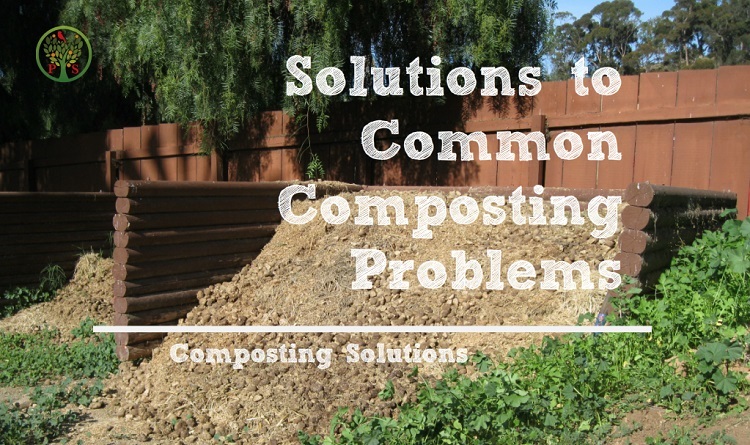Solutions to 10 Common Composting Problems
Composting problems? We’ve got solutions to some of the common composting problems.
Check out our composting page for more article on how to compost.
1. Compost Problems: Compost Not Decomposing
 Diagnosis:
Diagnosis:
- Your Compost Could be Too Dry. The soil microbes need moisture in order to decompose the organic material in the compost pile.
- Your Compost Pile is Too Small. There is a minimum mass of 3’ x 3’ needed for the compost pile to be effective.
- There is Not Enough Green Material in the Compost Pile. The green materials are responsible for initial thermal activity to “get the party started”. This is a common compost problem when a compost pile is built by just adding new materials to it. Our article on Composting 101 covers greens vs browns.
Solution:
- Wet Up the Compost Pile. Soil Moisture needs to be maintained at about 40% throughout the pile. Regularly monitor the pile and use a hose add moisture. Best time to add water is when you are turning the pile.
- Add Compost Material and Build a Bigger Compost Pile. Using a DIY Compost Bin you can calculate how much volume of material the compost bin will hold. Gather the additional materials and build the compost pile all at once. This will solve this common composting problem.
- Add Additional Green Material. Additional green material, such as manure or grass clipping should be well incorporated into the compost pile. Take the pile apart and mix the additional greens in thoroughly and then put them back into the compost bin.
2. Compost Problems: Compost Wet and Slimy
Diagnosis:
- Compost Pile has too Much Water. Adding too much water to a compost pile is detrimental to the composting microorganisms. They need air to continue to function effectively.
- Compost Pile Has Too Much Green. When the compost pile has too much green material and it is not turned it tends to get slimy. Many compost tumblers have this problem. Even through the tumbler mixes the materials when there is too much green and not enough brown, then it tends to get slimy. Best to use a compost bin or just a compost heap.
Solution:
- Add additional Brown Material. A compost pile that is too wet needs to be dried out. Adding additional brown material will help absorb the water. But make sure that your browns are not too dry. Pre-soaking them for about 15 minutes prior to incorporation into the pile is a good idea. You will need to take the contents of the compost pile out of the compost bin and mix in the brown material thoroughly – then add them back to the bin. A bit of work, yes, but this this the best solution to this compost problem.
- Same as A. Add Additional Brown Materials. Follow specific compost recipes for proper compost building.
3. Compost Problems: Pile Not Heating Up
Diagnosis:
- Compost Pile is Too Small. This common compost problem happens when the compost pile is too small, like trying to compost in a bucket. It just doesn’t work. A compost bin or compost heap should be 1 cubic yard minimum in size (3 x 3 x 3), but the bigger the better for more composting success.
- Not Enough High Nitrogen Material. High Nitrogen Material, aka “greens” are those with a narrow C:N Ratio that can activate the composting bacteria that initially heat up the compost pile.
Solution:
- Build a bigger compost pile. Follow this guide on how to compost. It begins with having sufficient materials to successfully compost. You will need to disassemble the compost pile you already have add additional materials to get the volume. Follow a composting recipe for the best success.
- Add High Nitrogen Material to the Pile. Check out this resource on composting materials to determine which High Nitrogen material you have available to add to the pile.
4. Compost Problems: Pile Heated Up But Did Not Stay Hot
Diagnosis:
- Not Right Ratio of Greens to Browns. If you have too many browns or not enough greens the compost pile will not stay hot and not sufficiently decompose the materials you added to the compost pile. This is a common composting problem, particularly when adding too many leaves to the compost pile.
Solution:
- Follow a Composting Recipe. There is a step-by-step method of being successful in composting.
5. Compost Problems: Compost Pile Steaming
Diagnosis:
- Compost Pile Has Heated Up. Too Hot? On cool fall morning you may see your compost pile steaming. Take out your compost thermometer to determine the internal temperature of the compost
Solution:
- Turn The Compost If Too Hot. A common composting problem is often ignored. If you don’t take the internal temperature of the compost pile, how do you know if it is too hot and has gone anaerobic? Compost needs to be turned when the temperature exceeds 131 degrees Farenheight for 3 consecutive days, or and more frequently when the temperature goes up. Above 160 degrees you risk the pile spontaneously combusting! So turn the pile if it is too hot.
6. Compost Problems: Leaves or Grass Clipping Matted & Not Decomposing
Diagnosis:
- Compost Pile Not Assembled Ideally. Matted leaves and grass clippings is a common composting problems. If material is simply dumped into the bin it tends to have a tendency to matt. These matted areas do not decompose because they are either too dry (leaves) or become anaerobic (grass clippings).
Solution:
- Mix Materials Throughly When Building the Compost Pile. The best compost method is when you build a compost pile all at once. You can have the right ratio of browns and greens that are specific to the type of plant you want to apply the compost to, AND you can mix all the compost materials together so that you avoid matting. This composting problem of matting is most problematic in the static pile and you have disassemble the pile and effectively “fluff” the matted layers for decomposition to commence again.
7. Compost Problems: Bad Smells
Diagnosis:
- Compost Pile Lacks Oxygen. Bad smells such as rotten eggs, vinegar, ammonia, and even vomit are the result of anaerobic (lack of oxygen) conditions. Anaerobic conditions are bad in that under these conditions the harmful microorganisms can thrives – those that cause plant diseases in particular. Do you want that on in your garden?
Solution:
- Compost Pile Must Be Aerated – Since nobody wants to put compost on the garden that may actually cause plant diseases, the compost pile must be aerated to remove those conditions where those microbes can thrive. Compost should be regularly monitored. When you smell those stinky conditions, this particular composting problems can be rectified by turning the compost pile. The interior of the compost pile is likely where there is a lack of oxygen, and so when you turn the pile, this material should be placed on the outside.
8. Compost Problems: Raccoons, Rats and Other Unwanted Critters
Diagnosis:
- Physical Evidence of Critters. This is an easy diagnosis. You may see scat or even the actual animal rummaging around your compost pile. They may be feasting on the food scraps, including meat or vegetable remains added to the pile.
Solution:
- Cover or Not Use Certain Materials. One of the prime reasons many of us want to compost is that we want to reduce the amount of waste going into the landfill. Hence we save our kitchen scraps and they go into the compost pile. But the critters love our scraps. Here’s a few solutions to this composting problems – first is to bury the food scraps in the compost pile so they are not on top. Add a layer of straw (grain free) on all sides will help slow them down. A compost pile that is covered with a tarp will also help but be sure to still allow for air circulation.If you still have a lot of problems, then the second line of defense is the kitchen scraps should go in a worm bin rather than a compost pile. I live in an area where there are bears so no food scraps at all go into my compost pile. They all go into a worm bin that has a secure lid. Find more composting tips in this article.
9. Compost Problems: Bugs – Fruit flies, gnats
Diagnosis:
- Physical Evidence of Critters. Obviously if you are seeing gnats and fruit flies and other bugs this is bothering you. If you are adding a lot of food scraps such as fruit waste and leaving the waste on top of the compost pile then these common composting problems will persist. Certain “bugs” will move into your compost pile once the compost is finished and this is natural, but it should only happen once the compost is finished. We cover how you can tell if your compost is finished in this Composting 101 article.
Solution:
- Cover or No Use Certain Materials. Like with the raccoon composting problems, if you find you have a lot of gnats or fruit flies flying around and it bothers you, then cover the compost pile or bury the materials. As an alternative simply don’t use those materials in the compost pile but rather add all food scraps to a worm bin that has a secure lid. A worm bin should also have a top layer of brown materials since the composting worms like it dark.
10. Compost Problems: Ants
Diagnosis
- Physical Evidence of Ants. If fire ants or other types of ants become part of the composting problems, generally ants will move in when the compost is dry or there is a large seed source for them to feed upon.
Solution:
- Keep the Compost Pile Moist. Generally speaking, the ants will move into compost when it is dry. Compost, even when it is finished, should be kept moist to keep the beneficial microbes active and ready to help your plants out when applied to your garden or other growing area. An active compost pile should have at least a 40% moisture content. Finished compost can have slightly less moisture but should not be dry. So keep the compost pile moist will solve the composting problems of pesky ants.


